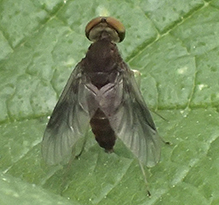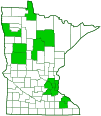quadrate snipe fly
(Chrysopilus quadratus)
Conservation • Description • Habitat • Ecology • Distribution • Taxonomy
|
|
||||||||||||||
Description |
Quadrate snipe fly is a small fly. It occurs in the United States east of the Great Plains and in southern Canada. It is fairly common in Minnesota. Adults are found from May to September in woodlands. Larvae are found in rotting wood and in leaf litter. Females are ¼″ to 5⁄16″ (7.0 to 8.0 mm) long, males a little smaller, ¼″ (6.0 to 6.5 mm) long. Females are tan or orangish brown with brown or dark brown markings. Males are darker; brown with blackish-brown markings, or dark orange with few contrasting markings. The head is more or less rounded. There are two large compound eyes on the side of the head and three small simple eyes (ocelli) in a triangle on top of the head. The back of the head is densely covered with long golden hairs. On the male the compound eyes are very large and meet at the top of the head. The front of the head is light gray and is covered on the lower half or two thirds with fine pale hairs. On the female the compound eyes are smaller and widely separated. The front of the head is brownish to almost blackish and is more or less covered with short, stiff, blackish hairs. On both sexes the antennae have three segments. The third segment is cone shaped, is not divided by rings (annulated), and bears a long, slender style (arista) at the end. The arista is distinctly longer than the antenna. The thorax has three segments. It is densely covered with short golden hairs. The genus name Chrysopilus translates to “gold hair”. The sides of the third segment (metapleura) are densely hairy. The abdomen on the male is narrow and tapered. On the female it is broad and is tapered at least on the lower half. Each abdominal segment may be dark on the front half and light on the back half, mostly light with a narrow dark band in front, or entirely light with no dark marking. The wings are mostly clear with darker brown markings. They are and tinged brownish, especially above the middle. A cell (stigma) on the leading edge (costal margin) is dark. Midway between the base and the wingtip there is a large, well-defined, almost rectangular, dark patch. The patch joins with the stigma and extends to the discal cell. Near the base of the wing there is a small, round, dark spot. The anal cell is longer than the second basal cell and is narrow but open at the wing margin. The legs are yellowish and relatively long. On the front legs the fourth segment does not have spurs at the end. On the hind legs there is just one spur at the end of the tibia. |
Size |
Male: ¼″ (6.0 to 6.5 mm) Female: ¼″ to 5⁄16″ (7.0 to 8.0 mm) |
Similar Species |
Habitat |
Woodlands |
Ecology |
Season |
May to September |
Behavior |
Like other eastern snipe flies, quadrate snipe fly does not bite. |
Life Cycle |
|
Larva Food |
|
Adult Food |
|
Distribution |
||
|
Sources Leonard, M. D. (1930). A Revision of the Dipterous Family Rhagionidae (Leptidae) in the United States and Canada. United States: American Entomological Society. |
|
| 11/18/2024 | ||
Occurrence |
||
Fairly common |
||
Taxonomy |
|
Order |
|
Suborder |
Brachycera |
Infraorder |
Orthorrhapha |
Parvorder |
Tabanomorpha (snipe flies and allies) |
Superfamily |
Rhagionoidea |
Family |
Rhagionidae (snipe flies) |
Subfamily |
Chrysopilinae |
Genus |
Chrysopilus |
Subfamily |
|
Subordinate Taxa |
|
|
|
Synonyms |
|
Chrysopilus dispar Chrysopilus flavidus Leptipalpus limbipennis Leptipalpus obscuripennis Leptis fumipennis Leptis quadratus |
|
Common Names |
|
quadrate snipe fly |
|
Glossary
Arista
A large bristle on the upper side of the third segment of the antenna of a fly. Plural: aristae.
Costal margin
The leading edge of the forewing of insects.
Ocellus
Simple eye; an eye with a single lens. Plural: ocelli.
Stigma
In plants, the portion of the female part of the flower that is receptive to pollen. In Lepidoptera, an area of specialized scent scales on the forewing of some skippers, hairstreaks, and moths. In other insects, a thickened, dark, or opaque cell on the leading edge of the wing.
Visitor Photos |
||
Share your photo of this insect. |
||
This button not working for you? |
||
Alfredo Colon |
||
 |
||
 |
 |
|
Babette Kis |
 |
Chrysopilus quadratus snipe fly male Chrysopilus quadratus, snipe fly, male, at Barnes Prairie hedgerow, Racine Co., WI. I find these flies in dappled shade areas, in hedgerows and shrubby areas. Photo was taken on July 3, 2022. |
MinnesotaSeasons.com Photos |
||
|
||
|

Slideshows |
|

Visitor Videos |
||
Share your video of this insect. |
||
This button not working for you? |
||
|
Other Videos |
||
|

Visitor Sightings |
||
Report a sighting of this insect. |
||
This button not working for you? |
||
Alfredo Colon |
Location: Albany, NY |
 |
| Alfredo Colon 8/8/2019 |
Location: Woodbury, MN |
 |
MinnesotaSeasons.com Sightings |
||
|

Created: 1/1/2021 Last Updated: © MinnesotaSeasons.com. All rights reserved. |

